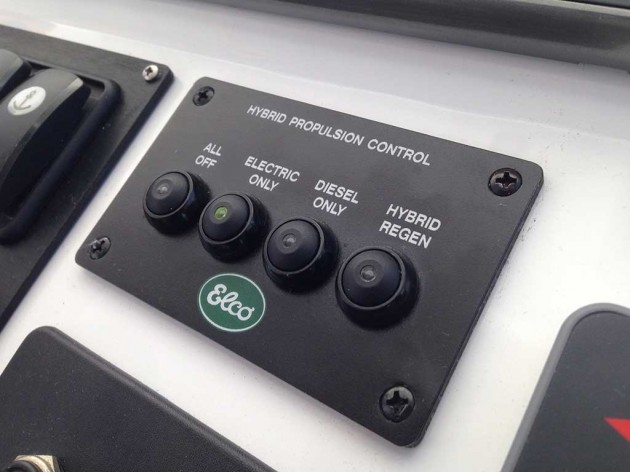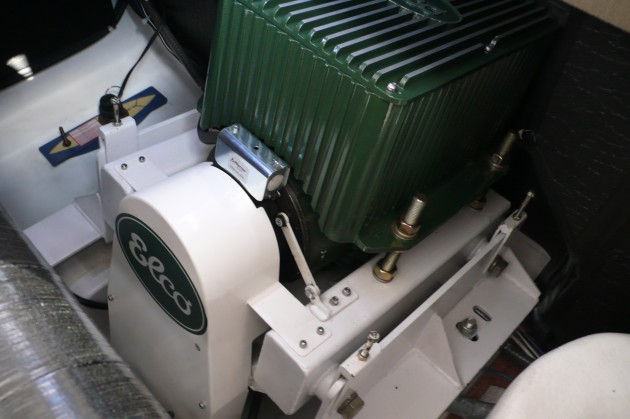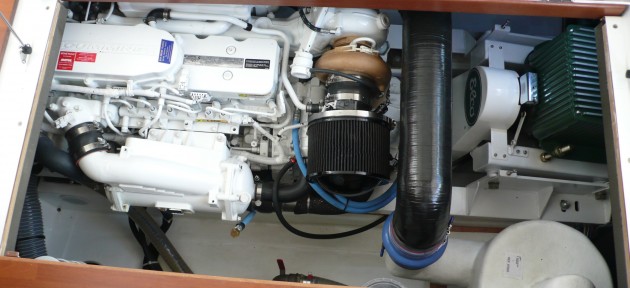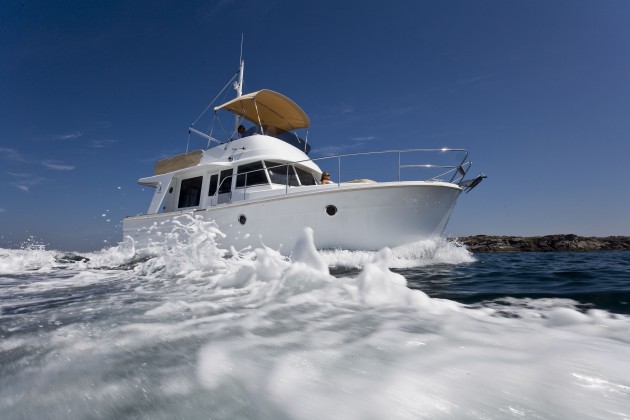Shock and Awesome: Beneteau Goes Hybrid With a Swift Trawler 34
The Beneteau Swift Trawler 34 is already a capable passage-making powerboat in almost every way. Can hybrid technology make it even better?
Hybrid technology is seemingly everywhere in the automotive world these days. And not just in small cars, but also in heavy trucks, buses, and sport utility vehicles. But what about the boating world; is this a technology that has any place in a boat? Well the answer is “sort of,” and not for the reasons you might think. Let me explain.
First of all, hybrid boats do exist. And no, we’re not talking about backyard and basement Frankenboat experiments with car batteries and trolling motors on Jon boats or small skiffs. Maybe you’ve heard of Seaway, the Slovenian boatbuilder that has been importing its Greenline diesel-electric hybrid boats to the United States since 2010.
The company manufactures the Greenline 33, the Greenline 40, and the Greenline 48 models, each powered by diesel engine(s) mated to an electric motor/generator that charges a bank of lithium batteries. In turn, those batteries power the electric motor/generator to spin the propeller via a clever clutch system. While there are certainly companies that have fiddled around with hybrid power well before Seaway came along, Greenline is really the first boat lineup that’s had any commercial success.
Greenlines are certainly very nice boats and their hybrid systems work flawlessly, but their slippery, sailboat-like hull forms compromise certain areas of handling, such as when traveling in a beam sea. So when Beneteau Power told me that it had a prototype hybrid version of its Swift Trawler 34 for me to check out—a capable boat I've run in all sorts of snotty conditions—I ran to a local marina to get a look at it.

Seaway's Greenline hybrid model range consists of 33-, 40-, and 48-footers powered by diesel or electric motors.
The idea behind the Swift Trawler 34 Hybrid is to take an already proven powerboat platform and see if it works as a hybrid. I can personally attest to the fact that the Beneteau Swift Trawler 34 is an excellent boat on its own, after delivering one up the full length of the Chesapeake Bay in a sporty 25- to 35-knot blow. Unlike the Greenline, which is designed almost expressly as a hybrid, the Beneteau Swift Trawler Hybrid is first and foremost a fast, capable, passage-making boat.
To get the job done, Beneteau enlisted Elco, a company with 120 years in the electric boat business. Elco started with a completely stock Beneteau Swift Trawler 34 (hull number 271), which had a 425-horsepower Cummins turbo diesel. That standard power plant is good enough to push the Swift Trawler 34 up to about 20 knots, with a reasonable and efficient cruise speed of around 15 knots.
To that Elco added a 72-volt, 20-horsepower belt drive electric motor/generator, a bank of 12 absorbed glass mat batteries, a 7.5-kilowatt diesel generator, a beefed-up battery charger, a battery management system, and helm control panel. Most everything else about the boat, including the five-bladed prop, is stock. The batteries, charger, generator, and electric motor/generator add approximately 2,200 pounds to the boat, and the batteries are situated in such a way as to keep the boat in trim. The whole system is installed so neatly and so far out of sight that I found it impossible to get decent pictures.

The only thing that gives away the hybrid status of the Swift Trawler 34 at the helm is this hybrid control panel.
As we got underway from Back Creek in Annapolis, MD, under electric power only, the thing I noticed first was the eerie silence. In fact, at full electric throttle I measured only 48 decibels at four knots (compared to 66 decibels with the engine driving the boat at the same speed). We took the boat all around the Annapolis waterfront and Severn River under electric power, running her through boat wakes and river chop with ease. Did I mention how quiet the boat is under electric power?
The Elco representatives aboard claimed a total run time on battery power alone of up to three hours and 45 minutes at full throttle. Run the generator to supply juice to the battery charger, and endurance increases to nine hours. Once the batteries are fully depleted, Elco tells me that it takes only two hours to recharge them to 98 percent with the engine driving the electric motor/generator, or about three hours using the battery charger (supplied with juice from shore power or the generator).
A user control panel and computerized management system administer the whole hybrid system. Under normal operation, the engine spins the prop shaft and the electric motor/generator, which charges the battery bank. Under electric-only operation, the prop shaft and propeller are freed from the engine’s transmission and spun by the electric motor via a heavy-duty belt. Elco says that aside form the occasional belt change, the only service required on the electric motor/generator is a primary bearing replacement at 50,000 hours. Batteries, of course, will require replacement every five to seven years, which could amount to a significant expense.

This 20-horsepower electric motor is the heart of the electric portion of the hybrid system that powers the Beneteau Swift Trawler 34 Hybrid.
With a full load of seven marine journalists and a 5-10 knot breeze, we were able to get the Swift Trawler 34 Hybrid up to 4.7 knots at 1908 rpm under electric power, with a draw of approximately 115 amps. Backed down to 3.6 knots at 1500 rpm, the draw went down to an extremely efficient 55 amps, which should provide a theoretical range of around 7.5 hours and 27 miles. That’s comparable to Seaway’s Greenline 33 hybrid, in case you’re wondering. The only performance issue I noted was a tendency for the propeller to cavitate in a hard turn under electric power, but this prop has a tendency to do that under regular power too.
You might think from the way I’ve described this boat that I’d tell everyone to run out and buy one, when and if they become available. Well, kind of. Sure, the hybrid aspect of this boat makes for great creek crawling, relaxed evening cruises, quietly plying your way into an anchorage at night, or simply reducing the hours you use your engine. I could see myself using it at the beginning or end of every trip, for just that reason alone.
But I wouldn’t recommend this boat to a buyer who wants to save hundreds of dollars in fuel and help save the planet, because that’s just not why you buy a Swift Trawler 34. I can’t think of anyone who would be happy motoring electrically to a long-range destination at four knots when they can cruise at 15.

A six-cylinder, 425-horsepower Cummins turbo diesel not only powers the propeller that pushes the Beneteau Swift Trawler 34 through the water, it also spins the Elco electric motor (right) to generate power that charges the hybrid battery bank.
The reason to get the hybrid system is for when you’re not trying to make 120 to 150 miles a day, but rather for when four knots is adequate, like coming and going from your slip, exploring a local creek, gunkholing, or when the primary engine goes down. In fact, the hybrid system makes for a very interesting–and likely less expensive than an auxiliary diesel–wing engine system for this boat.
Beneteau or Elco have not released pricing for the system or said whether it will become a factory option at any point, but it’s nice to know that the system can be installed after the boat is built, without any major structure modifications. In the mean time, stay tuned for more news on the Beneteau/Elco hybrid front.
For more information, visit Beneteau Power.


















